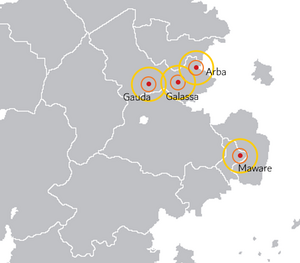Dayira

| Part of a series on |
| Bahia |
|---|
 |
| History |
| Geography |
| Politics |
| Languages |
| Notable settlements |
| Countries |
Dāʾira is a Badawiyic word meaning 'circle', a term first used by the Mai historian Gawon Rabiu, to describe a political model endemic to Bahia. Rabiu used the model to describe the decentralised and overlapping system of governance seen in Bahia before the onset of the Hourege system. Power was centred in Mijinis (city-states, known as x in Ndjarendie), which in most cases formed cooperative relationships with nearby Sares (villages), and tribal confederations. Rabiu noted that previous Euclean models had been hinged upon a unified, centralised state similar to their own, which did not exist in Bahia at the time. As he noted in 1931:
The system we see in early and medieval Euclea, of villages and cities gathered completely under the singular rule of a central authority, is missing in Bahia. It is apt to say that sovereignty was flexible and fluid. As long as the smaller mijini paid tribute to the larger, it did not matter how many or who it paid to.
Successful mijinis were able to form a network around them, extracting tribute, controlling natural resources, and monopolising lucrative trade routes. The system was as economical as it was political, being characterised by the Mufedha, a highly-mobile mercantile class who often achieved aristocratic status in most mijinis. Rabiu noted that this network was similar to the feudal system of Euclea and the later Hourege system of Bahia, in that states were linked in suzerain–tributary relationships, though the links were far more flexible and easily forged or broken.
The dayira model was eventually adopted by 20th century Euclean historians as a means of avoiding the term "state", which in the conventional sense did not adequately describe the complexities of classical Bahia. Not only did Bahian polities except Djedet not conform to classical Badawiyan and Euclean views of a state defined by territory with established borders and a central bureaucracy, but they considerably diverged in the opposite direction: the dayira was defined by its centre rather than its boundaries, and it could be composed of numerous other tributary polities without undergoing administrative, cultural, religious, or linguistic integration.